Posted by June Underwood on October 26th, 2007
I’m maundering around Robert Irwin and the concept of perception. It was the Oct 14 NY Times article on Irwin that got me thinking — again — about what and how and why we perceive.
Irwin, in one of his exhibits, made a small but significant change to a San Diego Museum room that overlooked a wide view of the Pacific ocean. His exhibit consisted of cutting three rectangles into the existing windows. The Times quotes Irwin, “At first I didn’t realize the glass was tinted….So not only did my holes let in air and sound, adding another dimension to the experience, but they made everything seen through them appear in greater focus.” The reporter adds that Irwin “opened the window, that age-old pictorial device, letting in a cool rush of reality.”
Alternatively, I think I spend much of my time in reality. So, to reverse Irwin, I’ve been painting “stuff” around my neighborhood base. No sweeping views of vales and rivers, of volcanoes and archaic structures. Instead, I’m trying to perceive, in a painterly fashion, the place I spend most of my time. As usual for me, it consists of much that is “natural,” that is, growing things.
As usual, it’s outside, where I can enjoy the sun (when it shines) and the air and light.
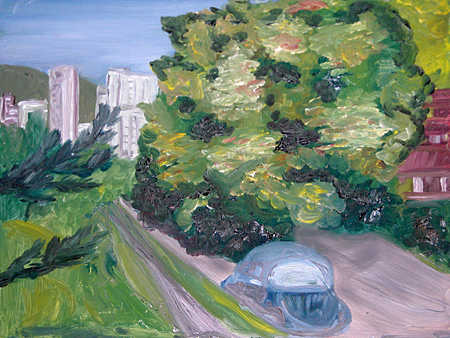 Volkswagen and Horse Chestnut tree, 12 x 16, Pleine aire
Volkswagen and Horse Chestnut tree, 12 x 16, Pleine aire
more… »
Posted by Steve Durbin on October 23rd, 2007
The biggest recorded earthquake in Montana history (magnitude 7.3) struck August 17, 1959, causing a huge landslide that dammed the Madison River (coming from Yellowstone Park) and created Quake Lake. Some 26-28 campers lost their lives, most of the bodies remaining under the millions of tons of rock. To me, they seem connected to the much larger number of trees that were drowned by the rising water, but remained standing bare, half-submerged.
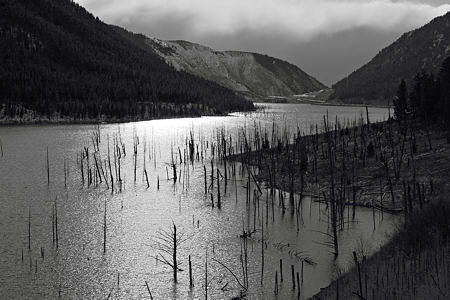
more… »
Posted by Richard Rothstein on October 14th, 2007
Since I last checked in with Art & Perception, I’ve been exploring the synthesis of two of my most persistent obsessions: Manhattan and beatuiful men. I was partly motivated by comments on this blog questioning my lack of people in my city views and details. As a result of that, I have of late gone in a completely opposite direction.
Truth be told, I rarely enoy nude male photography, it leaves me cold. Too obvious. On the other hand the naked city in all of its hardness, rigid angles and cubist statements is to my eye powerfully masculine and quite arousing. So I wondered if I could use my camera to create some kind of visual and emotional communication between the stone, steel and glass architecture, textures and colors of my adored metropolis and the architecture, textures and colors of beautiful men.
I’m not sure I’ve succeeded quite yet, but I do feel I am on the right path. And I must confess–not surprisingly–the exploration has been great fun.
Perhaps the strangest part of this experience has been that the sexual and visual pleasure that I’ve been experiencing during this process of of exploration has been unique and extraordinarily intense in ways I had not imagined. Furthermore, the experience has given rise to intense personal feelings that I’ve not experienced during the actual act of sex. Partly, this is because–with one exception–I have not indulged in sex with my models despite the fact that one of the criteria I’ve used to select my models has been powerful sexual attraction. Limiting myself to the visual experience has opened the door on new sensations and much more powerful visual experience than I’ve ever had before.
more… »
Posted by June Underwood on September 14th, 2007
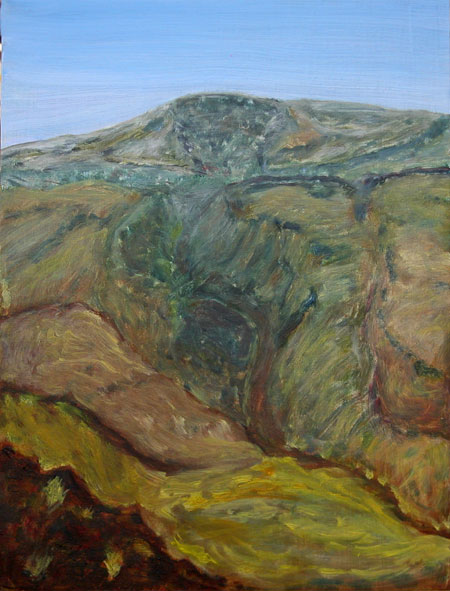
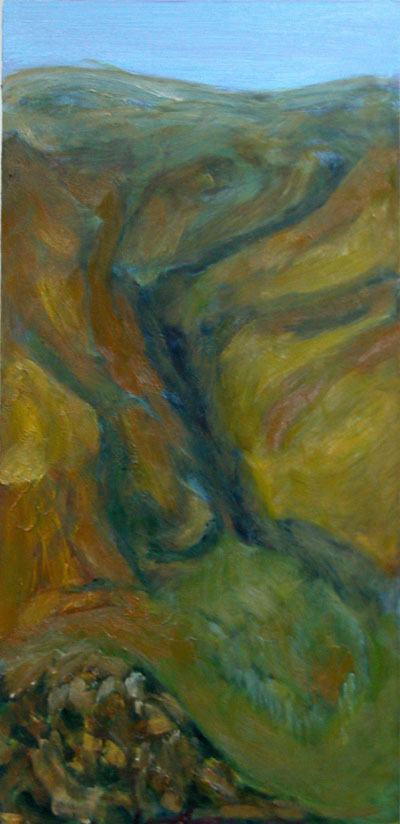
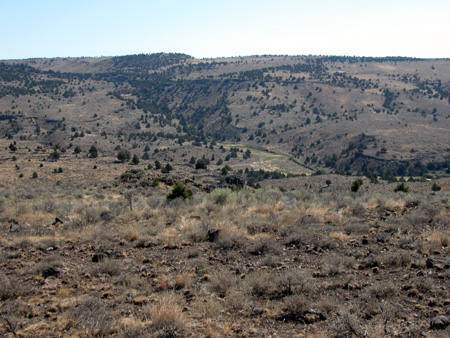
Underwood, Stinking Water Area, large and small oil on masonite, and a photograph, off the Stinking Water Acess Road.
“I took my easel and canvas and brushes to the top of the bluff, and painted two views from the same spot…. From this enchanting spot there was nothing to arrest the eye from ranging over [the Missouri’s] waters for the distance of twenty or thirty miles.”
[Artist George Catlin, as quoted in William H. Truettner, The Natural Man Observed: A Study of Catlin’s Indian Gallery (Washington, D.C.: Smithsonian Institution Press, 1979), p. 247, found on the of the Smithsonian website.
As Karl said (here) one has to become acquainted with the landscape before one can paint it. And as George Catlin remarked about a different landscape “there was nothing to arrest the eye…for the distance of twenty or thirty miles.
Aside from artistic masochism, why do we paint landscapes?
more… »
Posted by Angela Ferreira on September 10th, 2007
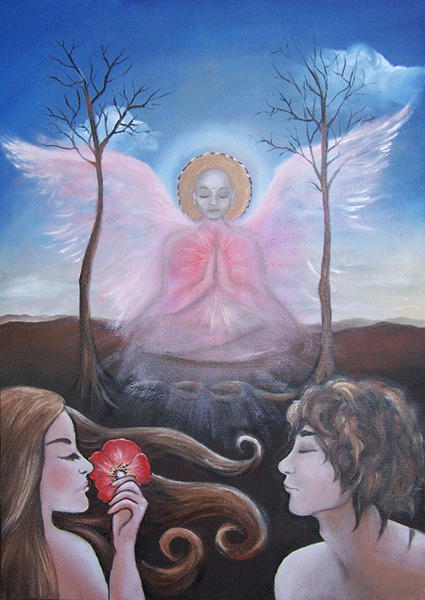
Sitting and meditating lately about what is really life about that makes up get up in the morning and carry on as artists…
Is it how much money you got in the bank? The partner of our dreams? That new car you been saving up? The Exhibition you booked for?
Or is it the peace of mind, security and happiness that all this acquirements provide us?
What is really life about?
It’s very easy to confuse values with goals, but they are very different – goals are specific ways in which you might express your values…
Now, think for yourself, what you really value in your life? You might say “my job”, but then ask yourself “What is your job in the service of?” You might answer “Financial security”. Keep asking the same question “What is financial security in the service of?” Keep on asking the question until can’t find an answer and you have found your value.
Values are what life is about, and it it’s all about happiness. Know your values! Happiness is what makes my life worth for, ask yourself!
Everything else my dear collegues, it will before long turn to dust…
Posted by June Underwood on August 31st, 2007
I’m just back from a pleine aire, oil painting workshop and it seems that my topic — to paint in the middle in the muddle or to recollect in tranquility — has arisen again on A&P. Hi Sunil…..
Obviously I’m fascinated with the immediate ambiance as much as I am with the final product. The milieu from which I just returned, however, had its problems. The big one was the lack of focus within the landscapes we were asked to paint. So the topic of the day is — how do you find your viewpoints and hold them? more… »
Posted by Sunil Gangadharan on August 30th, 2007
Karl recently mentioned here that he prefers (and revels) painting in the context of his reaction to his surroundings. He averred to say that a photo of the landscape would not do justice because
“Photographs record what a place looked like at a particular moment. They don’t record what it felt like to be there”
My personal experience is a little different. more… »
 Volkswagen and Horse Chestnut tree, 12 x 16, Pleine aire
Volkswagen and Horse Chestnut tree, 12 x 16, Pleine aire








